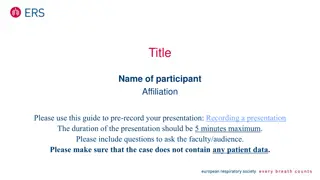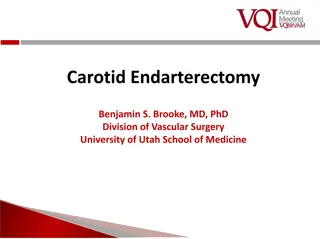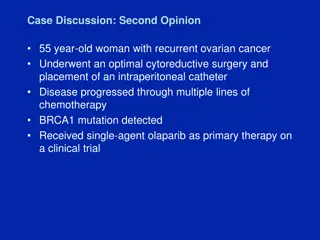CASE DISCUSSION
In an in-depth analysis guided by Dr. Batoul Birjandi, this discussion scrutinizes clinical cases to unveil insights and approaches crucial for medical practitioners. Delve into a thorough examination of complex medical scenarios and learn valuable lessons relevant to various healthcare specialties in this enlightening discourse.
Download Presentation

Please find below an Image/Link to download the presentation.
The content on the website is provided AS IS for your information and personal use only. It may not be sold, licensed, or shared on other websites without obtaining consent from the author.If you encounter any issues during the download, it is possible that the publisher has removed the file from their server.
You are allowed to download the files provided on this website for personal or commercial use, subject to the condition that they are used lawfully. All files are the property of their respective owners.
The content on the website is provided AS IS for your information and personal use only. It may not be sold, licensed, or shared on other websites without obtaining consent from the author.
E N D
Presentation Transcript
CASE DISCUSSION By: DrBatoulBirjandi
Patients with MAS have a somatic (postzygotic) mutation of the alpha subunit ofthe Gprotein thatactivates adenylyl cyclase. This mutation leads to continued stimulation of endocrine function (eg, precocious puberty, thyrotoxicosis, gigantism or acromegaly, Cushing syndrome,and hypophosphatemicrickets) in various combinations. Mutations can be found in other non-endocrine organs (liver and heart) resulting in cholestasis and/or hepatitis, intestinal polyps, and cardiac arrhythmias, respectively. A heightened risk of malignancy has also been reported Germlineoccurrences ofthis mutationwould presumably be lethal .Lumbroso S et al J Clin Endocrinol Metab 2004; 89:2107.
caf-au-lait spots Triad Triad Precocious puberty Precocious puberty- - endocrinopathies endocrinopathies Fibrous dysplasia bone
Collins et al Collins et al. Orphanet Journal of Rare Diseases 2012 2012, 7(Suppl 1):S4
Caf-au-lait spots can be seen in MAS are typically the first manifestation of the disease, usually appearing either at or shortly after birth. As such,they can be an early clue to the diagnosis. usually show some association with ( respect ) to the midline.( while this is often the case, there are frequent exceptions). Contrary to what has been previously reported, we have not observed a correlation between the size of the spots and the extent of the disease. Nor have observed a correlation between side of the body on which the spot is found and the side of the body on which the FD is found. The caf -au-lait spots seen in association with FD are the result of gsp-bearing melanocytes in which the mutation brings about c-AMP-mediated tyrosinase gene activation and melanin production in mutation-bearing cells There are no well-defined effective treatments for the hyperpigmentation seen in MAS Collins et al. Orphanet Journal of Rare Diseases 2012, 7(Suppl 1):S4
fibrous dysplasia Bone disease may present as polyostotic or monostotic fibrous dysplasia. Polyostotic involvement characterized by multiple separated foci of dysplasia-is typically seen in the face but also in the extremities, or both. Fibrous dysplasia of the extremities predisposes for pathological fractures. Massive thickening of the facial bones may lead to bizarre disfigurement with cosmetic and psychosocial sequel. Further, the encasement of cranial nerves carries the risk of function loss, like visual impairmentor hearing loss. Sometimes the syndrome may lead to enhanced intracranial pressure. IV bisphosphonates (particularly pamidronate, alendronate, and zoledronate) may have beneficial effects on the bony disease, with regard to reducing both bone pain and the frequency of pathologic fractures. Classen et al. Journal of Medical Case Reports 2012, 6:32
Precocious puberty In girls In boys far more common in girls typical presentation bleeding(Typically painless, sometimes profuse, and usually accompanied by the development of breast tissue(Tanner II or III) The first episode can occur as early as during the first few months of life or as late as age 6 or 7 years & subsequent episodes are highly unpredictable. Classic biochemical findings : elevated estradiol and estrone levels with suppressed gonadotropins Pelvic ultrasound typically reveals a large unilateral ovarian cyst which may be hemorrhagic and appear to have mixed cystic and solid elements in most cases adults with MAS have been able to have children Current treatment: anti-estrogens Very rare consists of vaginal when present, is more likely to be subtle and indolent in boys limited to the testicular Sertoli cells resulted in either unilateral or bilateral macroorchidism without precocious puberty many of these cases have also been associated with testicular microlithiasis, which has also been identified in males of all ages with MAS combination therapy in the form of an androgen receptor blocker (spironolactone, flutamide or cyproterone acetate) along with a compound that interferes with sex steroid synthesis (ketoconazole or an aromatase inhibitor) Collins et al. Orphanet Journal of Rare Diseases 2012, 7(Suppl 1):S4
Growth hormone excess It is always accompanied by skull base FD the vast majority of patients also have hyperprolactinemia. if a patient with precocious puberty achieves his/her predicted height, this can be a sign of GH excess, as precocious puberty should have resulted in short stature. the most important reason to diagnose GH excess in association with FD is that it is associated with an increase in morbidity, specifically in the craniofacial region. GH excess in FD is associated with macrocephaly and vision loss. Collins et al. Orphanet Journal of Rare Diseases 2012, 7(Suppl 1):S4
Thyroid 2/3 of the patients had involvement of the thyroid when assessed by the most sensitive method for assessing thyroid. about 1/2 of the patients who had involvement of the thyroid detected on ultrasound had frank hyperthyroidism. the thyroid findings exist along a spectrum from an isolated area seen on ultrasound with no clinical findings to patients with obvious goiters, and hyperthyroidism that is unable to be adequately controlled with medications and requires either surgery or ablation. the gsp mutation : activation of the TSH/G-protein/cAMP result in both hyperplasia and hyperfunction. Additionally, results in increased T4 to T3 conversion (T3 dom) In patients in whom the only abnormality is an abnormal ultrasound, it is important to continue to check TSH and thyroid hormone periodically as the development of frank hyperthyroidism may occur later. The ultrasound findings in MAS are usually a mixture of mostly cystic with some solid lesions(Swiss cheese appearance) definitive treatment, which usually means surgery or ablation with radioactive iodine. Collins et al. Orphanet Journal of Rare Diseases 2012, 7(Suppl 1):S4
Hypophosphatemia Overproduction of FGF23 by FD tissue was found to be the cause unlike many other extraskeletal manifestations aspects, renal phosphate wasting can spontaneously resolve as patients age The clinical sequelae and significance of hypophosphatemia are an earlier age of first fracture, more fractures,and bone pain Treatment of hypophosphatemia is the same as in other FGF23-mediated phosphate wasting disorders, and involves the use of phosphate and active vitamin D (calcitriol or alfacalcidiol) Collins et al. Orphanet Journal of Rare Diseases 2012, 7(Suppl 1):S4
Cushings syndrome the rarest of endocrine abnormalities found in MAS It always occurs in the neonatal period, which parallels the involution of the fetal adrenal gland and may suggest a differential effect of the gsp mutation on the fetal adrenal, which is supported by the fact that both glands are always involved Associated with increased and early mortality(Most of the early mortality associated with Cushing s syndrome in MAS is due to opportunistic infectionsnotably for Pneumocystis species Treatment. usually involves surgical removal of diseased adrenal glands Collins et al. Orphanet Journal of Rare Diseases 2012, 7(Suppl 1):S4
Methods Methods: : All studies and case reports of acromegaly in patients with MAS were systematically sought in the world literature up to January 2013. Also included new data (from three unreported cases) and updated data on 23 previously reported patients from two centers.(N=112) Salenave Salenave et al J Clin Endocrinol Metab, June 2014, 99(6):1955 1969
Acromegaly Acromegaly in MAS Prevalence 40-130/million 20-30% MAS MAS: 1/100000-1/1000000 Mean of age 40 30 Adenoma in imaging 95%(pure+mix) 54% Surgery response 70% micro &50% macroadenoma 12%
Treatment Surgery: Difficult or impossible in patients with MAS (due to the thickness of the cranial dysplasia at the skull base particularly when it involves the sphenoid bone and to the risk of hemorrhage given the high vascularity of fibrous dysplasia ) and generally requires performing a total hypophysectomy due to diffuse involvement of the pituitary. Only 25 of 112 patient underwent surgery.(trans-sphenoidal, transethmoidal,transfrontal) Acromegaly was controlled postoperatively in only three (12%) of the 25 patients operated; one had been irradiated by gamma-knife before surgery and th other two had either a large or a total hypophysectomy. Interestingly, on examining a series of pituitary specimens removed at surgery or obtained at autopsy, it was observed that the disease was diffuse in the pituitary, with hyperplastic and neoplastic changes associated with overrepresentation of somatotroph cells in structurally intact tissue areas. Genetic analysis of multiple microdissected samples of any type of histological areas consistently revealed identical GNAS mutations in individual patients. This suggests that the primary change underlying acromegaly in patients with MAS is somatotroph hyperplasia involving the entire pituitary gland, with or without development of a somatotroph adenoma. Salenave et al J Clin Endocrinol Metab, June 2014, 99(6):1955 1969 t
Medical management: Medical treatment is preferred in patients with MAS-associated acromegaly. SAs improve GH/IGF-1 levels in most patients, but do not achieve normal levels in the majority. In these patients, the GH receptor antagonist pegvisomant is often effective at normalizing IGF- 1 levels. Since most of the GH secreting tumors co-secrete prolactin, dopamine agonists are usually necessary. drug DAs 12.5% (4 of 32 patients) SAs DAs 32% (18 of 56 patients) (14% macro & 46% micro) 76% (10 of 13 patients) Response(%) Pegvisomant Salenave Salenave et al J Clin Endocrinol Metab, June 2014, 99(6):1955 1969
Due to the convenience of treatment (once monthly injections), SAs remain the first intention treatment. If, after a short (3 6 mo) trial of SA, IGF-1 levels decrease but do not normalize, the addition of pegvisomant to SA may be proposed rather than shifting from SA to pegvisomant, as in sporadic acromegaly Salenave Salenave et al J Clin Endocrinol Metab, June 2014, 99(6):1955 1969
High-dose intramuscular octreotide in patients with acromegaly inadequately controlled on conventional somatostatin analogue therapy: a randomized controlled trial Design: A 24-week prospective, multicentre, randomised, open-label trial conducted from 12 December 2005 to 23 October 2007 in patients with persistently uncontrolled acromegaly despite 6month conventional SSA therapy. Methods: Patients with 50% reduction in GH levels during previous SSA treatment were randomized to high-dose (60 mg/28 days) or high-frequency (30 mg/21 days) octreotide i.m. injection. Primary end-points were week 12 and 24 reduction in serum IGF1 and GH from baseline. Secondary end points included IGF1 normalisation and tumour shrinkage rates, and safety/tolerability evaluations. Andrea Giustina et al. European Journal of Endocrinology (2009) 161 331 338
Results: Significantly, more patients (10 out of 11) achieved week 24 IGF1 reduction in the high-dose than the high-frequency group (8 out of 15; P<0.05). In the high-dose group only, week-24 IGF1 values were significantly reduced (P=0.02) versus baseline. Normalisation of IGF1 occurred only with the high-dose regimen (4/11; P=0.02).
Radiation: Pituitary irradiation was used in 29 cases Radiotherapy was reported to be effective in only four patients(13%) the disease was not controlled by irradiation alone in four, and all needed adjuvant therapy Radiotherapy is not a good choice in these patients, due to the stimulation of sarcomatous transformation of dysplastic bones Salenave Salenave et al J Clin Endocrinol Metab, June 2014 2014, 99(6):1955 1969
PLAN: Increasing the dose of sandostatin LAR( up to 60 mg) F/U 6 month later with IGF1,GH























